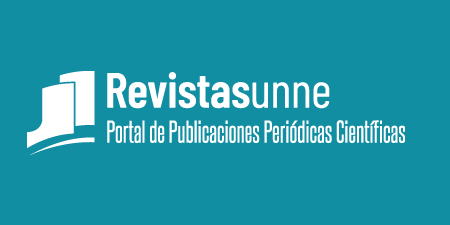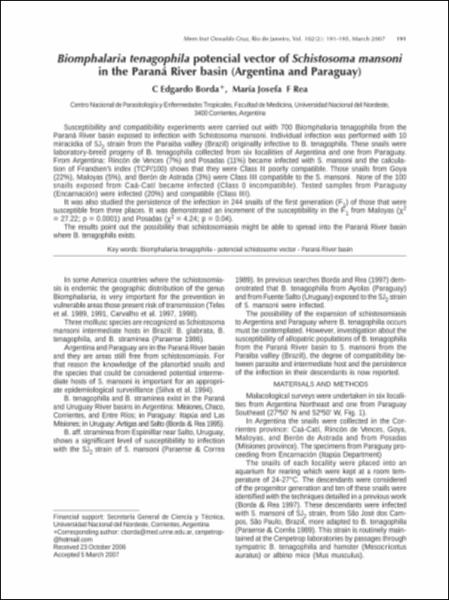Mostrar el registro sencillo del ítem
Biomphalaria tenagophila potencial vector of schistosoma mansoni in the Paraná River basin (Argentina and Paraguay)
| dc.contributor.author | Borda, Carlos Edgardo | |
| dc.contributor.author | Rea, María Josefa Felisa | |
| dc.date.accessioned | 2022-07-13T12:18:36Z | |
| dc.date.available | 2022-07-13T12:18:36Z | |
| dc.date.issued | 2007-03 | |
| dc.identifier.citation | Borda, Carlos Edgardo y Rea, María Josefa Felisa, 2007. Biomphalaria tenagophila potencial vector of schistosoma mansoni in the Paraná River basin (Argentina and Paraguay). Memórias do Instituto Oswaldo Cruz. Río de Janeiro: Ministério da Saúde. Instituto Oswaldo Cruz, vol. 102, no. 2, p. 191-195. ISSN-e 1678-8060. | es |
| dc.identifier.issn | 0074-0276 | es |
| dc.identifier.uri | http://repositorio.unne.edu.ar/handle/123456789/49524 | |
| dc.description.abstract | Susceptibility and compatibility experiments were carried out with 700 Biomphalaria tenagophila from the Paraná River basin exposed to infection with Schistosoma mansoni. Individual infection was performed with 10 miracidia of SJ2 strain from the Paraiba valley (Brazil) originally infective to B. tenagophila. These snails were laboratory-breed progeny of B. tenagophila collected from six localities of Argentina and one from Paraguay. From Argentina: Rincón de Vences (7%) and Posadas (11%) became infected with S. mansoni and the calculation of Frandsen’s index (TCP/100) shows that they were Class II poorly compatible. Those snails from Goya (22%), Maloyas (5%), and Berón de Astrada (3%) were Class III compatible to the S. mansoni. None of the 100 snails exposed from Caá-Catí became infected (Class 0 incompatible). Tested samples from Paraguay (Encarnación) were infected (20%) and compatible (Class III). It was also studied the persistence of the infection in 244 snails of the first generation (F1) of those that were susceptible from three places. It was demonstrated an increment of the susceptibility in the F1 from Maloyas (χ2 = 27.22; p = 0.0001) and Posadas (χ2 = 4.24; p = 0.04). The results point out the possibility that schistosomiasis might be able to spread into the Paraná River basin where B. tenagophila exists. | es |
| dc.format | application/pdf | es |
| dc.language.iso | eng | es |
| dc.publisher | Ministério da Saúde. Instituto Oswaldo Cruz | es |
| dc.rights | openAccess | es |
| dc.rights.uri | http://creativecommons.org/licenses/by-nc-nd/2.5/ar/ | es |
| dc.source | Memórias do Instituto Oswaldo Cruz, 2007, vol. 102, no. 2, p. 191-195. | es |
| dc.subject | Biomphalaria tenagophila | es |
| dc.subject | Potencial schistosome vector | es |
| dc.subject | Paraná River basin | es |
| dc.title | Biomphalaria tenagophila potencial vector of schistosoma mansoni in the Paraná River basin (Argentina and Paraguay) | es |
| dc.type | Artículo | es |
| unne.affiliation | Fil: Borda, Carlos Edgardo. Universidad Nacional del Nordeste. Facultad de Medicina; Argentina. | es |
| unne.affiliation | Fil: Rea, María Josefa Felisa. Universidad Nacional del Nordeste. Facultad de Medicina; Argentina. | es |
| unne.journal.pais | Brasil | es |
| unne.journal.ciudad | Rio de Janeiro | es |
| unne.ISSN-e | 1678-8060 | es |
Ficheros en el ítem
Este ítem aparece en la(s) siguiente(s) colección(ones)
-
Artículos de revista [166]





